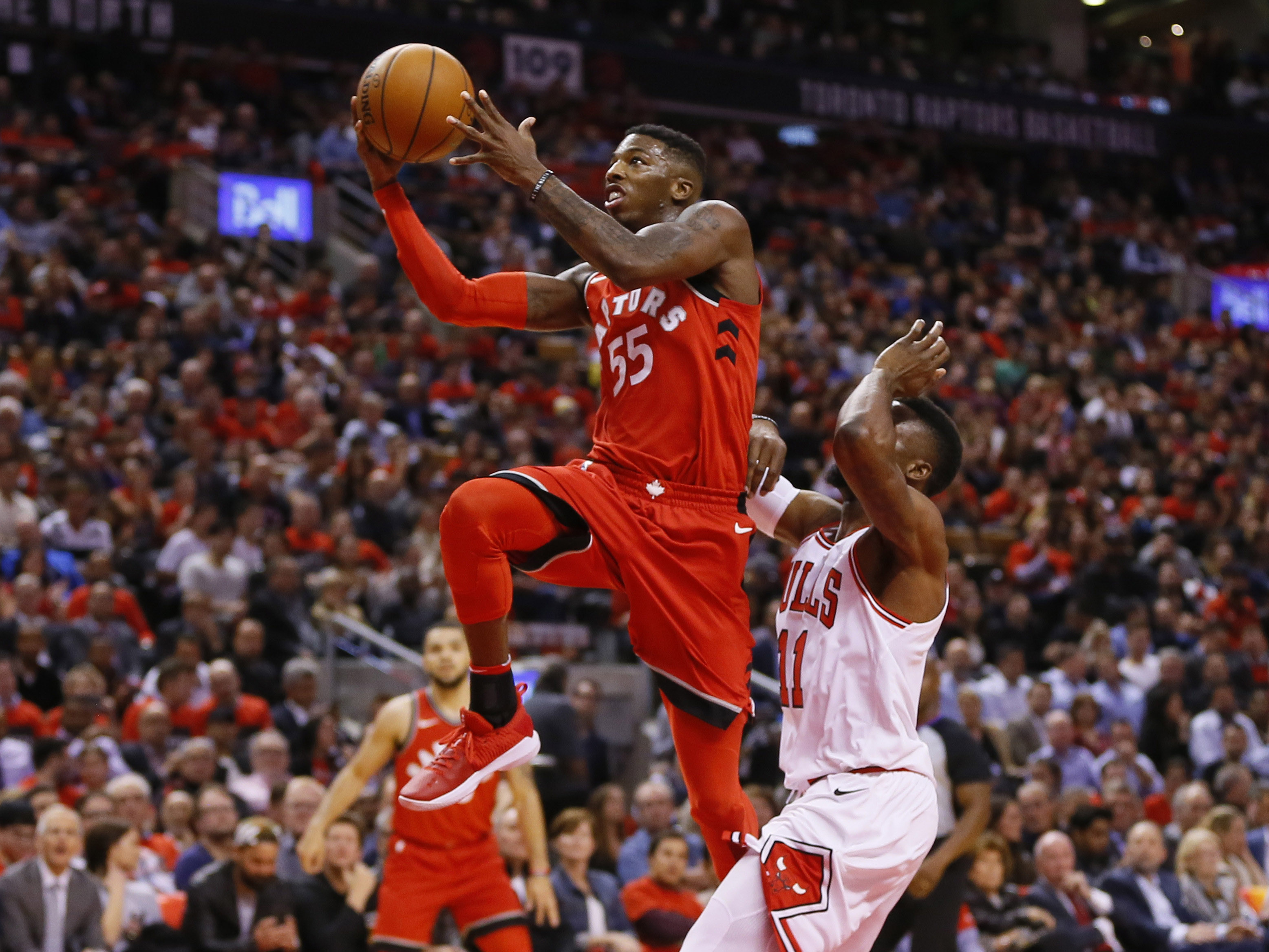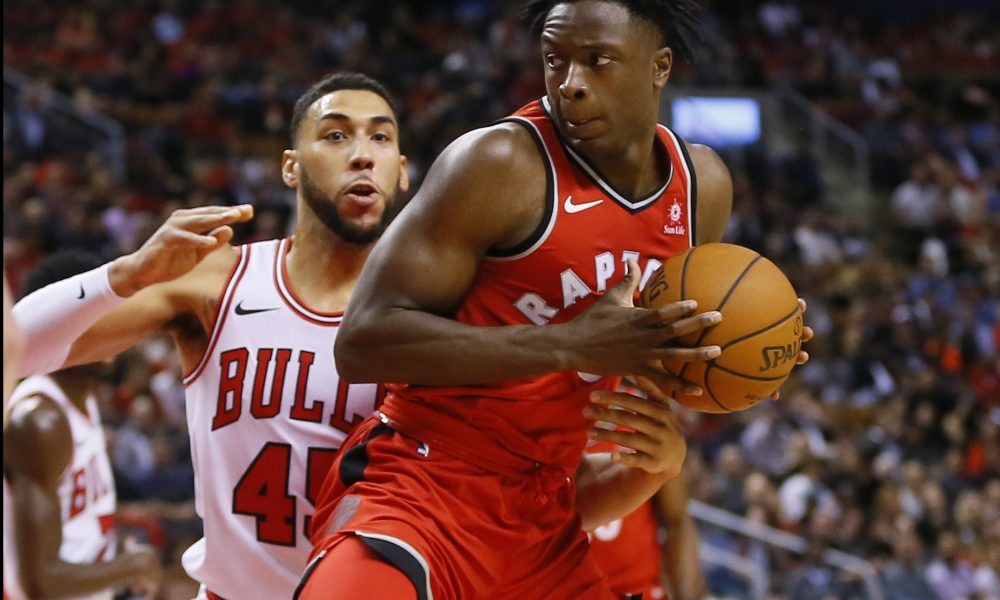Breaking Down Delon Wright in the Pick and Roll
Since Delon Wright returned from injury partway through last season, he has shown an incredible ability to bend the opposing defense when orchestrating a pick and roll. What makes Wright so special in these scenarios is not incredible athleticism, nor is it incredible strength. Wright’s success in pick and rolls is a result of his ability to do everything and be incredibly versatile, regardless of what the defense shows. Compiled in the video above is around 2 minutes of film of Wright in pick and rolls, illustrating his ability to make crafty finishes at the rim, get his defender leaning before rejecting the screen, keep his defender on his back while “snaking” his dribble, find a weak side advantage, and “short” aggressive defenses.
To get a more detailed analysis of Wright’s pick and roll prowess, we’ll break down his game against the Chicago Bulls, where he manned the second unit and carved up their defense for 13 points and 5 assists.
Finishing at the rim
On this play, Wright attacked the defense early with a pick and roll. While crossing half court, David Nwaba is met with a pseudo Drag Screen set by Jakob Poeltl. Identifying that Nwaba is having difficulty negotiating the screen so high up the floor, Wright lowers his shoulder and immediately bursts toward the lane. Nwaba had more than enough real estate to slip under the screen and meet Wright at the other side without conceding any meaningful ground. However, Wright’s ability to quickly notice this misstep allowed him to have a beat on Nwaba.
On the weak side of the floor is Kay Felder, who digs down away from Fred Van Vleet to impede Wright’s drive to the rim. Anticipating the swipe, Wright picks up his dribble and starts his gather towards the rim. Doing all of this in quick succession allowed Wright to stroll to the rim and finish without meeting a properly set defense.
Rejecting the screen
Once again Nwaba has matched up with Wright, only this time in a completely non-transition setting. Because he was able to set up, Nwaba was able force Wright away from the middle of the floor, negating his use of the screen. Wright’s quick crossover uses Nwaba’s momentum against him while rejecting the double screen. By the time Wright has started his drive towards the baseline, Nwaba is several strides behind Wright.
In a defensive scheme where Nwaba is negating the middle of the floor, the screener’s defender is typically supposed to drop towards the baseline and be perpendicular to the ball handlers drive. Since this was a double screen, Paul Zipser and Cristiano Felicio are unsure as to who should drop. Their indecisiveness worked against them, as Wright’s quick drive caught both of them out of position, aligning themselves completely parallel to his drive. With a half step on the closest trailing defender and impending weak side help, Wright used a scoop finish in rhythm with his dribble to evade any meaningful contest at the rim.
Finding weak side advantage
While the previous two examples show how Wright’s quick decision making and ability to catch defender’s off guard enabled him to finish at the rim, he also showed his ability to identify an advantage when other defenders rotate and help.
Once again, Wright has found himself driving towards the baseline against a backpedalling Chicago big man. This time, Felicio is the sole big man defender but is still unable to cut off Wright’s drive by setting his feet perpendicular. Wright drives right at Felicio, forcing him to unnaturally shift his weight. Using Felicio’s momentum against him, Wright quickly cut back toward the middle and drew a tertiary defender on his way to the rim. Since Zipser completely abandoned his assignment, OG Anunoby, in the corner and Nwaba failed to rotate down and pick him up, Anunoby was able to make a basket cut freely. Once both defenders were drawn on Wright, the weak side advantage was found and Anunoby was given 2 points on a silver platter.
“Shorting” the pick and roll
Racking up 5 assists in a game as a backup point guard is impressive, as it indicates a clear ability to put teammates in a position to score. However, sometimes an advantage can be created without receiving traditional credit. This is where the “hockey assist” comes into play, specifically with “shorting” the pick and roll.
Simply put, when a defense decides to aggressively show, hedge, or double team on a pick and roll, the ball handler can not always pass to the diving screener because of unclear passing lanes. However, if teammates are spaced out properly, that ball handler can “short” the pick and roll by passing to a teammate strictly for the purpose of them passing to the rolling screener from a better angle.
Chicago made the odd decision to aggressively show to the level of the screen on pick and rolls throughout the game, and Wright made them pay here by quickly swinging the ball to Anunoby once Poeltl wisely slipped the screen. Anunoby had position to pass the ball to Poeltl in the middle of the paint with his man, Felicio, shielded on his back. The quick thinking of all involved led to a pair of free throws.
Closing Thoughts
Unfortunately, there weren’t any good examples of Wright putting his defender on his hip while he snaked into the lane during this game, but there are plenty of examples of this (and all the other concepts discussed above) that are in the compilation video above.
Wright is an exciting talent on both ends of the floor, but his expertise in pick and rolls and ability to maximize any advantage he identifies the defense gives him is what sets him apart from most young point guards.



